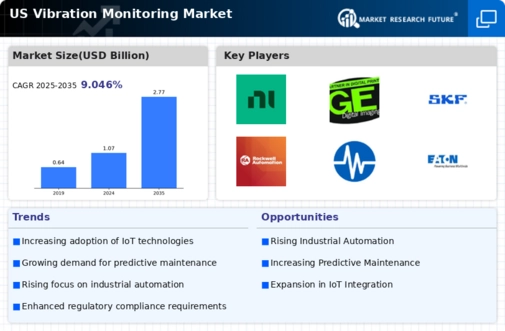Rising Demand for Industrial Automation
The increasing demand for industrial automation in the US is a pivotal driver for the vibration monitoring market. As industries strive for enhanced efficiency and reduced operational costs, automation technologies are being integrated into manufacturing processes. This shift necessitates the implementation of vibration monitoring systems to ensure machinery operates within optimal parameters. According to industry reports, the automation market is projected to grow at a CAGR of approximately 10% through 2026. Consequently, the vibration monitoring market is likely to experience a corresponding surge, as companies seek to mitigate downtime and enhance productivity through real-time monitoring solutions.
Focus on Energy Efficiency and Sustainability
The growing focus on energy efficiency and sustainability in the US is influencing the vibration monitoring market. Companies are increasingly adopting practices that minimize energy consumption and reduce environmental impact. Vibration monitoring systems play a crucial role in this transition by enabling organizations to optimize machinery performance and reduce waste. The vibration monitoring market is likely to see a surge in demand as businesses seek to align with sustainability goals. Reports suggest that energy-efficient technologies can lead to savings of up to 30% in operational costs, further driving the adoption of vibration monitoring solutions to enhance energy management.
Growing Awareness of Equipment Health Monitoring
There is a growing awareness among US manufacturers regarding the importance of equipment health monitoring, which significantly influences the vibration monitoring market. Companies are increasingly recognizing that proactive monitoring can lead to substantial cost savings by preventing unexpected equipment failures. The vibration monitoring market is expected to benefit from this trend, as organizations invest in advanced monitoring technologies. Reports indicate that the market for predictive maintenance solutions is anticipated to reach $12 billion by 2025, highlighting the potential for vibration monitoring systems to play a crucial role in maintaining equipment reliability and operational efficiency.
Technological Advancements in Sensor Technologies
Technological advancements in sensor technologies are driving innovation within the vibration monitoring market. The development of more sensitive and accurate sensors allows for better detection of vibration anomalies, leading to improved predictive maintenance strategies. These advancements enable industries to monitor equipment health in real-time, thus enhancing operational efficiency. The vibration monitoring market is likely to see increased adoption of these advanced sensors, as they provide critical data that can be analyzed to predict failures. As sensor technology continues to evolve, the market is expected to expand, with a projected growth rate of around 8% annually over the next five years.
Increased Investment in Infrastructure Development
Increased investment in infrastructure development across the US is a significant driver for the vibration monitoring market. As the government and private sectors allocate funds for upgrading and maintaining infrastructure, the need for reliable monitoring systems becomes paramount. Vibration monitoring systems are essential for assessing the health of structures such as bridges, roads, and buildings. The vibration monitoring market is poised to benefit from this trend, as infrastructure projects often require stringent monitoring to ensure safety and compliance with regulations. With an estimated $1 trillion earmarked for infrastructure improvements, the demand for vibration monitoring solutions is expected to rise substantially.
















Leave a Comment